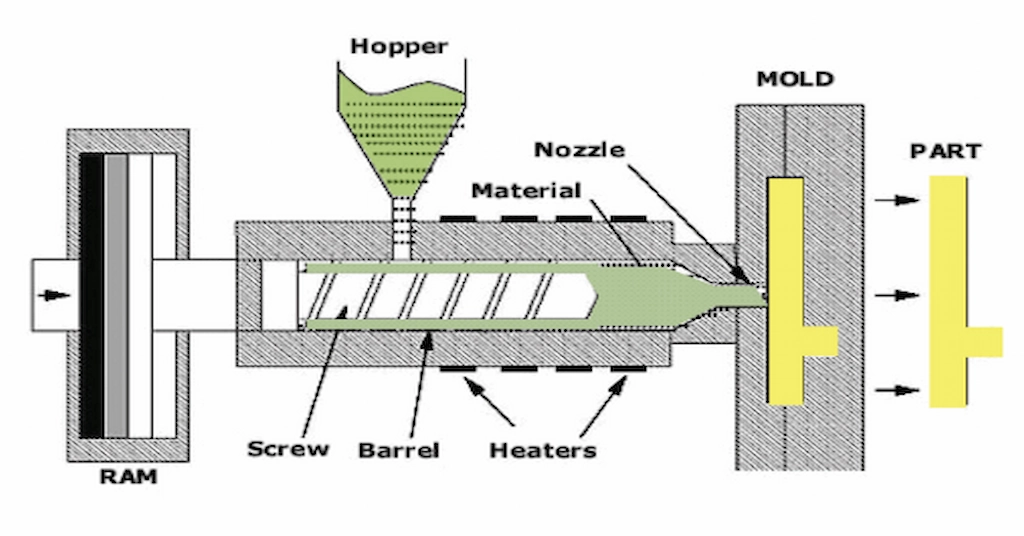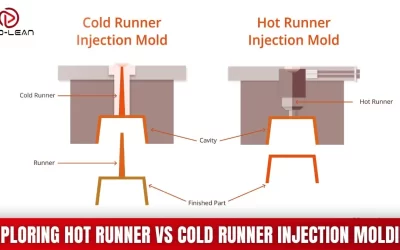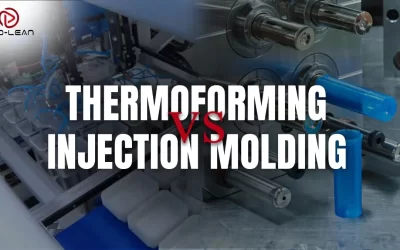“Quality control in injection molding stands as a cornerstone for both cost optimization and achieving seamless outcomes. It’s not just a process but a commitment to bring excellence and reliability from start to finish.”

Quality control for injection molding is an optimal systematic process intended to ensure the expectations and standards of a desired product. It involves a detailed and structured approach to mitigate potential failures before initiating large-scale production. Ineffective quality assurance can result in unsatisfactory outcomes, leading to a loss in utility and resources. Therefore, it is essential to adhere to established quality standards to achieve the desired outcome.
The preliminary phases for quality assurance in injection molding are planning, designing, making, and implementing these strategies. This article highlights the quality parameters associated with injection molding, primary failures that occur during the process, and how to overcome them.
Understanding of Injection Molding
First, it’s essential to know about injection molding before going into details about its quality control methodologies. Injection molding refers to the procedure of shaping functional prototypes by injecting the molten plastic into a mold cavity. This mold then melts the plastic resin and shapes it into a desired form.

Injection molding setup
Moreover, this process ensures effective control over the size and shape of the product and is subject to rigorous quality and regulatory standards. Injection molding finds extensive applications in the medical to aerospace industries. Furthermore, It helps in making durable and reliable products that are FDA-approved.
The final step entails a comprehensive inspection of quality and dimensions, assuring they meet the required standards. This involves verifying measurements for accuracy, functionality, and adherence to specifications. Finally, inspection results are documented and a certification is created, providing evidence of compliance with quality standards and regulations.
Try Prolean Now!
Stages Involved in Quality Control For Injection Molding
Generally, there are four stages involved in Quality Control for Injection Molding product manufacturing.

Steps for quality control in injection molding
1- The Design
The first and foremost important phase of quality control is design. The design engineers, tooling specialists, and quality assurance professionals collaborate to review the design before proceeding with further steps. Initially, a design for manufacturability analysis is conducted to anticipate potential challenges.
Additionally, by assessing material flow dynamics, potential defect risks such as air traps or insufficient filling can be identified and mitigated. This phase lays the groundwork for the later steps and involves the creation of the primary mold design.
2- Pre-production Inspection
Now comes the second step, “Pre-production Inspection’’. It involves verifying critical dimensions, tolerances, and surface finishes to ensure compliance with specifications. The sole purpose of this step is to validate the functionality of the mold.
Pre-production inspection typically includes precision measurements of the “first article design’’ using tools like calipers, micrometers, and coordinate measuring machines (CMMs) to ensure part dimensions and tolerances meet design specifications.
3- In-process Quality Control
In-process quality control involves continuous monitoring of product quality with stringent control measures. This includes;
- Real-time monitoring of critical process parameters such as temperature, pressure, and cycle times.
- Trained professionals conduct visual inspections to ensure surface finishing and dimension accuracy.
- Statistical Process Control (SPC) techniques are applied to analyze process data, utilizing control charts to monitor variation over time.
- Immediate corrective measures are taken if any defects or faults are identified, ensuring consistency throughout the manufacturing process.
4- Final Inspection
The final step entails a comprehensive inspection of quality and dimensions, assuring they meet the required standards. This involves verifying measurements for accuracy, functionality, and adherence to specifications.
Finally, inspection results are documented and a certification is created, providing evidence of compliance with quality standards and regulations.
Methodologies Used for Quality Control in Injection Molding
There are various methodologies, tools, and systems utilized for the quality inspection of injection molding products.
Total Quality Management (TQM): TQM improves the quality of products and services through continuous refinement.
Computer-Aided Quality (CAQ): CAQ uses computer systems and software applications to manage and control quality-related processes that streamline quality management activities and improve efficiency.
Advanced Quality Planning (AQP): AQP ensures quality in a product from the design phase onwards. It is typically used in industries like automotive manufacturing to prevent defects before they occur.
Statistical Process Control (SPC): SPC uses statistical techniques to monitor and control production processes in real time to prevent variations in the manufacturing process.
Continuous Process Control (CPC): CPC maintains process stability and consistency over time. It implements control measures and feedback systems that continuously monitor and adjust process parameters for consistent quality output.
Integrated Automation (TIA): TIA uses advanced technologies such as robotics, sensors, and data analytics to integrate all aspects of manufacturing operations into a single cohesive system to optimize manufacturing processes and improve efficiency.
These methodologies and systems play crucial roles in testifying high-quality injection molding manufacturing processes and products.
Key Inspection Parameters For Injection Molding
In the injection molding process, certain strategic parameters that dictate the overall efficiency and quality are carefully monitored. These play an important role in quality control management for optimized manufacturing processes with minimized defects.
- Injection Pressure
Injection pressure is the force applied during the injection of molten material into the mold cavity. This pressure is meticulously controlled to ensure thorough mold filling, thereby preventing defects like incomplete shots. To maintain precision, sensors are integrated into the injection unit, providing real-time data on pressure exertion throughout the injection phase.
- Injection Time
The injection time in injection molding refers to the duration during which molten material is injected into the mold cavity. It plays a crucial role in maintaining consistency and quality in the molded parts by preventing issues such as overpacking or material degradation. To maintain precision, the injection molding machine’s control system measures and precisely calculates the injection time based on preset parameters and feedback from sensors.
- Injection Speed
Injection speed directly influences the material flow dynamics. Hence, it is carefully regulated to prevent any defects like flow lines or air entrapment. The sensors within the injection molding machine precisely measure the speed at which the material is injected into the mold cavity.
- Mold Temperature
The temperature of the mold during the injection molding process significantly impacts the dimensions of the molded parts, as well as the cycle time. Further, precise temperature control prevents defects such as warping or sink marks. For this purpose, thermocouples or temperature sensors are embedded within the mold cavity to measure the mold temperature. These sensors provide real-time temperature data for precise temperature regulation.
- Cooling Time
After the molded material is injected into the mold, it remains in the mold for a certain period to cool down and solidify. Maintaining proper cooling time prevents deformation or stress-related defects. Timers monitor the cooling time and keep track of the duration for which the molded parts remain within the mold cavity after injection.
- Holding Pressure and Time
After the material is injected inside the mold cavity, holding pressure is applied for a specific time. It prevents material shrinkage and ensures proper cavity packing. The holding pressure and time are carefully adjusted to maintain consistency and prevent material degradation. They are monitored by the pressure sensors and timers within the molding machine.
Moreover, these process inspection parameters for injection molding ensure the quality and consistency of the final product. By implementing quality control in injection molding, consistent quality products are produced with minimal defects.
Try Prolean Now!
What Molding Defects Could Impact the Product Quality?
Various defects could impact the quality of the product formation. Here are some common problems encountered during the injection molding process along with their respective reasons.
Table: Common molding defects in injection molding
| S N | Defects | Reasons |
| 1 | Short Shot | This occurs when the molten plastic does not fill the mold cavity, leading to incomplete parts. Also, short shots appear due to improper injection pressure, temperature, or inadequate mold design. |
| 2 | Flash | Flash refers to excess material that escapes the mold cavity and forms thin fins or protrusions along the parting line. It occurs when the mold is not properly clamped or when injection pressure is too high. |
| 3 | Sink Marks | These appear as depressions on the surface of the molded part, typically caused by uneven cooling or insufficient packing pressure during the solidification phase of the plastic. |
| 4 | Warpage | Warpage is the deformation of the molded part from its intended shape. It can result from uneven cooling rates across the part or improper gate placement, leading to differential shrinkage and distortion. |
| 5 | Weld Lines | These occur when two flow fronts meet and form a visible line on the surface of the part. Insufficient mold temperature or poor material flow can create weak bonds between the molten plastic, resulting in weld lines. |
| 6 | Burn Marks | Burn marks are discolored areas on the surface of the molded part, typically caused by overheating of the material or mold. This can result from excessive mold or material temperature, leading to thermal degradation. |
| 7 | Flow Marks | Flow marks appear as streaks or lines on the surface of the part, caused by rapid cooling of the material or improper flow during injection. High injection speeds or incorrect flow rates can contribute to this issue. |
| 8 | Jetting | Jetting occurs when the molten plastic shoots through the mold cavity, creating visible streaks or jets on the surface. It can result from high melt viscosity or improper gate design, leading to turbulent flow. |
| 9 | Splay Marks | Splay marks are surface defects caused by the presence of moisture in the plastic material, which vaporizes during injection, leaving behind voids and streaks. Proper drying of the material is essential to prevent splay marks. |
| 10 | Voids/Bubbles | Voids or bubbles within the molded part are typically caused by trapped air or moisture during the injection process. Proper venting, material drying, and mold design can help minimize the occurrence of voids and bubbles. |
The Importance of Quality Control in Injection Mold Manufacturing
Quality control plays a crucial role in injection mold manufacturing for several key reasons: Let’s evaluate the importance of quality control terminology in Injection molding.
1. Ensuring Product Consistency
The accurate dimensions, tolerances, and suitable material flow are critical for achieving the desired functionality in the final product. This is ensured by quality control in injection molding for consistent production of high volumes of parts. Moreover, It ensures that each part produced meets the required specifications consistently, maintaining uniformity across the entire production run.
2. Minimizing Defects and Waste
Quality control helps identify and rectify defects early in the manufacturing process. It helps to reduce scrap rates and minimizes material waste. This ultimately leads to cost savings and enhanced efficiency. Through quality control, product manufacturers can address preliminary issues such as wear, fatigue, and stress concentrations.
3. Meeting Customer Requirements
Injection mold manufacturers must meet the quality standards specified by their customers. Implementing substantial quality control processes assures that the manufactured molds meet customer expectations, enhancing satisfaction and fostering long-term relationships.
4. Enhancing Product Performance
High-quality injection molds result in parts with superior performance characteristics, such as dimensional accuracy, surface finish, and mechanical properties. Effective quality control ensures molds are designed and manufactured to achieve optimal performance.
5. Reducing Downtime and Rework
Defective molds can lead to production downtime and the need for repairs, resulting in delays and increased costs. Quality control helps identify potential issues early, allowing for timely corrective actions and minimizing disruptions.
6. Continuous Improvement
Quality control is not just about identifying and correcting defects; it also involves analyzing data and feedback to identify areas for improvement. By continuously monitoring and refining manufacturing processes, injection mold manufacturers can achieve higher levels of quality, efficiency, and innovation.
Get ISO Certified Quality Assurance in Injection Molding Projects Prolean
At Pro-lean we follow ISO 9001:2015 standards and provide high-quality injection molding services from functional plastic prototypes to rapid production needs. With our technical and skilled team of professionals, we prioritize attention to detail to enhance product design and performance with minimum lead time.
We are committed to providing quality molds and services by considering the completion of each successful project with keen quality considerations inch by inch. So send us your design and get an instant quote!
Read more:
- Rapid Injection Molding: Accelerating Product Development Cycles
- Injection Molding Defects: Causes and Solutions
- A Comprehensive Guide to EDM Drilling: Applications and Advantages
Try Prolean Now!
Summing Up
Quality control is essential in injection mold manufacturing to deliver high-quality molds and minimize defects and waste. It enables product designers to meet customer expectations, comply with regulations, and drive continuous improvement in processes and products.
Monitoring and regulating, the key process parameters helps to identify improvement opportunities and produce consistent quality products. Moreover, the delivery of consistently high-quality products enhances the manufacturer’s reputation.
FAQs
Q1- How can I ensure consistency in injection molding?
To ensure consistent quality in injection molding, certain determinants should be kept in mind. For instance, choose the right design and best injection molding materials for your parts, and optimize the mold design by considering factors, such as; mold’s geometry, size, runner system, gate location, venting, and cooling channels, etc. Also, by controlling the performance parameters and performing regular maintenance you can ensure the consistency in your injection molding process.
Q2- What factors influence quality control for injection molding?
Several key factors define how well the product aligns with the predetermined design and overall quality. For instance;
- Dimensional stability,
- Molding defects
- Color, and
- Gloss
Q3- How does dimensional stability affect the quality?
Dimensional stability ensures compatibility during the assembly phase. It refers to the ability of a part to maintain its intended dimensions and shape over time, despite changes in critical parameters such as temperature, humidity, or mechanical stress. So, It directly impacts the aesthetic appearance of parts and the long-term performance along with the product’s durability.
Q4- What is the role of gloss in product quality?
The role of gloss in injection molding is significant as it directly impacts the aesthetic appeal and perceived quality of the molded parts. Gloss refers to the reflective quality of the surface finish of the molded part, which can range from high gloss to matte.




0 Comments